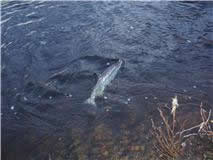These bulletin blogs represent news about Finavon and the South Esk, and my views as a riparian owner. They are not the views of any other organisation, nor are they designed to promote the interests of any individual or organisation other than Finavon Castle Water and factors affecting the fishery. Tony Andrews
Today the River had dropped back to the top of the Red Brae wall (on the webcam this shows some water coming over the armchair rock, and a good swirl on either side of it) and this meant that it was a perfect height for Tyndals Pool, which comes into its own after a spate as the water is dropping back. Today Tyndals was mine for the day. I decided the level was too high and the current too fierce to wade across at the top of the pool. Instead I decided to fish Willows through first, and then wade across at the top of that pool to the north bank and walk up the bank to the head of Tyndals. While fishing Willows I saw three fish, one of which was certainly a kelt, but, judging by their positions in the pool ( just off the point of the willows) I reckon the other two were fresh fish.
Encouraged by seeing fish I started at the Armchair Boulder at the head of Tyndals (the one you see on the webcam) and fished down the pool steadily, handlining the last few feet into the slack water on the north side of the main stream. Just below the ‘elbow’ there was a long draw and the reel spoke. After a brief but lively fight I netted and returned a bright little fish of about 7lbs. As I was starting to fish again a nice fresh fish showed in more-or-less the exact spot where I hooked my fish. I then moved on down the pool, fishing a Wetcel 2 and medium fast sinking leader with about 24″ of 12lbs polycarbon cast, and a size 6 double hook Yellow Torrish.
I fished the pool all the way down, past the two north bank groynes, and when I reached the dub at the very tail of the pool, with the fly swinging across the stream smoothly and at just the right speed and depth, it stopped and I tightened into a fish which for the first minute I was convinced was a kelt. I was soon to be convinced otherwise when the fish made a long run down into the Willows, ending in two lunging jumps and taking most of the backing off the reel. Big fish! It repeated the reel stripping runs three times more before gradually coming under control.
After a long struggle I netted the fish which, in terms of length (36″ approx) should have been 20lbs+. Unfortunately it had the most horrendous gash in its belly which had only partly healed, but sufficiently to indicate that the wound was probably received at sea. Although the fish had no sea lice, its general condition was just about OK, although it was probably 6-8lbs underweight as a result of its injury. I estimate its weight to be about 14lbs. Judging by the length and depth of the wound I would be surprised if the fish had not been severely curtailed in feeding after the predatory attack. I thought about killing the fish on the grounds that there was very little prospect of its surviving to November or December to spawn, but decided that there was sufficient doubt, despite its poor condition, to justify returning it to the river alive. I just hope that it makes it to the redds. This is the second fish we have caught this year at Finavon with severe damage almost certainly caused by sea mammals of one species or another.
The most encouraging thing about today was the number of other fish I saw on Milton Beat.
TA
